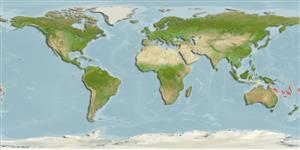Elasmobranchii (sharks and rays) >
Myliobatiformes (Stingrays) >
Urolophidae (Round rays)
Etymology: Urolophus: Greek, oura = tail + Greek, lophos = crest (Ref. 45335); deforgesi: Named for Bertrand Richer de Forges of the Institute de Recherche pour le Développemen, for promoting the recent exploration of the bathyal fauna off New Caledonia and for collecting valuable fish specimens from cruise surveys (Ref. 51067).
Eponymy: Dr Bertrand Richer-de-Forges (d: 1948) is a French carcinologist and marine biologist who (since 1984) has been based at ORSTOM, Noumea, New Caledonia. [...] (Ref. 128868), visit book page.
More on authors: Séret & Last.
Environment: milieu / climate zone / depth range / distribution range
Ecology
Marine; bathydemersal; depth range 203 - 330 m (Ref. 51067). Deep-water
Western Central Pacific: Chesterfield Islands.
Size / Weight / Age
Maturity: Lm ? range ? - ? cm
Max length : 34.2 cm TL male/unsexed; (Ref. 51067)
Short description
Identification keys | Morphology | Morphometrics
Dorsal spines (total): 0; Vertebrae: 151 - 157. Weakly rhomboidal disc, width less than 70% total length; rather long tail, postcoacal length more than 75% of disc length; short head (ventral length mostly less than 30% total length) and snout (length to eye less than 15% total length); narrow, cartilaginous interorbit less than 4% total length; internasal flap greatly expanded posteriorly; no broad lobes on posterolateral border of nostrils; inner margin of spiracle oblique; no lateral tail folds; no dorsal fin; apices of pelvic fins rounded; 7-8 oral papillae arranged along a 'W' line on mouth floor; 96-102 pectoral fin radials; total vertebrae more than 150; dorsal surface uniform yellowish brown (Ref. 51067).
Inhabits the continental slope (Ref. 51067).
Life cycle and mating behavior
Maturity | Reproduction | Spawning | Eggs | Fecundity | Larvae
Séret, B. and P. Last, 2003. Description of four new stingarees of the genus Urolophus (Batoidea: Urolophidae) from the Coral Sea, South-West Pacific. Cybium 27(4):307-320. (Ref. 51067)
IUCN Red List Status (Ref. 130435: Version 2024-2)
Threat to humans
Harmless
Human uses
Tools
Special reports
Download XML
Internet sources
Estimates based on models
Preferred temperature (Ref.
123201): 4.2 - 5.6, mean 4.8 °C (based on 48 cells).
Phylogenetic diversity index (Ref.
82804): PD
50 = 0.5000 [Uniqueness, from 0.5 = low to 2.0 = high].
Bayesian length-weight: a=0.00813 (0.00372 - 0.01775), b=3.08 (2.88 - 3.28), in cm total length, based on LWR estimates for this (Sub)family-body shape (Ref.
93245).
Trophic level (Ref.
69278): 3.5 ±0.4 se; based on size and trophs of closest relatives
Resilience (Ref.
120179): Low, minimum population doubling time 4.5 - 14 years (Assuming fecundity<100).
Fishing Vulnerability (Ref.
59153): Low vulnerability (24 of 100).
